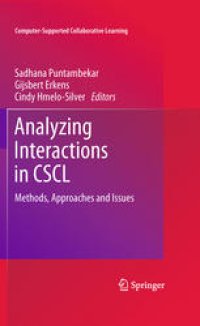
Ebook: Analyzing Interactions in CSCL: Methods, Approaches and Issues
- Tags: Educational Technology, Artificial Intelligence (incl. Robotics)
- Series: Computer-Supported Collaborative Learning Series 12
- Year: 2011
- Publisher: Springer US
- Edition: 1
- Language: English
- pdf
Analyzing Collaborative Interactions in CSCL Methods, Approaches, and Issues Sadhana Puntambekar, Gijsbert Erkens, and Cindy Hmelo-Silver, editors In more than two decades of research in CSCL (Computer-Supported Collaborative Learning), researchers have used several methods to understand how individuals learn in groups and how groups of learners construct knowledge. The individual and group learning processes have been studied using a variety of methods. Analyzing Collaborative Interactions in CSCL reveals the wide range of this research: qualitative and quantitative methods, studies of the learning process as well as outcomes, and the measurement of group and individual members’ learning. Focusing on three major research areas—group processes, learning within groups, and frameworks for analyzing CSCL—leading scholars present models, methods, and tools that readers can adapt to fit their own projects. Basic research issues such as defining the unit of analysis, determining the grain size of the data, and representing the temporality of interactions are discussed in the context of these methods addressing issues such as: • Studying group cognition through the lens of social order. • Using visualization methods to assess group members’ individual progress. • Analyzing collaborative interactions with data mining methods. • Assessing student project groups online and offline. • Using multilevel analysis in text-based communication. • Analyzing collaborative interactions across settings and domains. Together, the chapters in Analyzing Collaborative Interactions in CSCL model a range of methods for CSCL researchers in education, education technology, and cognitive science.
Analyzing Interactions in CSCL: Methodology, Approaches, and Issues deepens the understanding of ways to document and analyze interactions in CSCL and informs the design of the next generation of CSCL tools. It provides researchers with several alternative methodologies, theoretical underpinnings of the methods used, data indicating how the method worked, guidance for using the methods, implications for understanding collaborative processes and their effect on learning outcomes and implications for design. CSCL research tends to span across several disciplines such as education, psychology, computer science and artificial intelligence. As a result, the methods for data collection and analysis are interdisciplinary, from fields such as sociology, anthropology, psychology, computer science, and artificial intelligence. This book brings perspectives together, and provides researchers with an array of methodologies to document and analyze collaborative interactions.